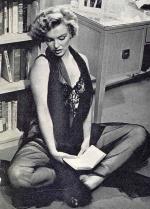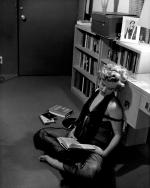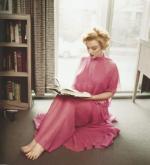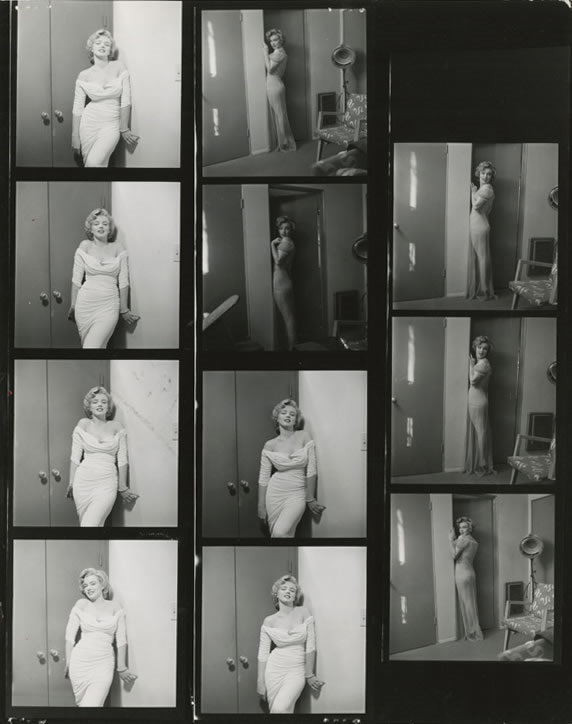01/1952, Beverly Carlton Hotel - Séance LIFE, Jour 1: En déshabillé par Halsman & Lloyd
Premier jour de la séance photos de Marilyn Monroe avec le photographe Philippe Halsman fin janvier 1952 chez elle, dans son appartement au Beverly Carlton Hotel pour Life Magazine (voir Life 7 avril 1952 ).
Pour cette deuxième séance photos, Philippe Halsman est accompagné de son assistant John Baird, du publicitaire de Life Stanley Flink, et d'Harold Lloyd qui, invité par Halsman, va photographier les coulisses de la séance à travers des photographies en couleur et en 3 dimensions.
First day of Marilyn Monroe's photoshoot with photographer Philippe Halsman end of January 1952 at her home, in her apartment at the Beverly Carlton Hotel for Life Magazine (see Life 7 avril 1952 ).
For this second photoshoot, Philippe Halsman is accompanied by his assistant John Baird, Life's publicist Stanley Flink, and Harold Lloyd who, invited by Halsman, photograph the backstage of the shoot through color photographs and in 3 dimensions.
- Séance en déshabillé -
Negligee Sitting
Après avoir photographié Marilyn en robe blanche (voir la séance En robe blanche ), Philippe Halsman s'attèle à une autre mise en situation pour Marilyn: la photographier habillée en lingerie. Convenu à l'avance avec Marilyn et son publicitaire de la Fox Roy Craft, ce dernier avait fait parvenir une dizaine de déshabillés chez Marilyn. C'est Halsman qui sélectionne les tenues puis il réfléchit au lieu où il placera Marilyn.
After having photographed Marilyn in a white dress (see the session In White Dress ), Philippe Halsman tackles another scenario for Marilyn: photographing her dressed in lingerie. Agreed in advance with Marilyn and her Fox advertiser Roy Craft, the latter had sent about ten negligee to Marilyn. It is Halsman who selects the outfits then he thinks about where he will place Marilyn.
- Déshabillé Noir -
Black Negligee
Philippe Halsman racontera (dans le magazine Photography de juin 1953 ) comment il a trouvé ses idées et ses impressions: "Ma curiosité a été éveillée par la seule photographie dans la pièce. À ma grande surprise, j'ai reconnu le visage d'Eleonora Duse. Marilyn a-t-elle affiché cette image juste pour impressionner les intellectuels itinérants ? J'ai posé quelques questions et j'ai été surpris de découvrir que Marilyn en savait non seulement beaucoup sur elle, mais que la Divine Duse était sa grande idole. (...) J'ai décidé d'inclure la photo de Duse. Il y avait un tourne-disque sur l'étagère. Marilyn, en déshabillé transparent, s'y adossa, écoutant avec une rêverie haletante un disque. Son derrière pointait vers le visage immortel de la Duse. Pour moi, ce n'était pas un sacrilège. C'était mon commentaire ironique sur le changement de valeurs dans notre civilisation."
Philippe Halsman will tell (in the magazine Photography de juin 1953 ) how he found his ideas and his impressions: "My curiosity was aroused by the only photograph in the room. To my surprise I recognized the face of Eleonora Duse. Did Marilyn display this picture just to impress itinerant intellectuals ? I asked a few questions and was startled to find that Marilyn not only knew a lot about her, but that the Divine Duse was her great idol. (...) I decided to include Duse's photograph. There was a record player on the bookshelf. Marilyn, in a transparent negligee, leaned against it, listening with breathless dreaminess to a record. Her derrière was pointing toward Duse's immortal face. To me it was no sacrilege. It was my ironic comment on the shift of values in our civilization."
- Photos de Philippe Halsman -







- Planches Contact -
- Contact Sheet -


- En coulisses par Harold Lloyd -
- Déshabillé Rose -
Pink Negligee
Le photographe s'étonne aussi de l'aménagement: "Les étagères de Marilyn étaient pleines des livres les plus disparates - sur la religion, la science, l'histoire, la psychologie et les traductions de classiques français, russes et allemands. Cela aussi était surprenant et une bonne occasion de faire une image éducative. Ma photo suivante montrait la magnifique blonde, dans son déshabillé transparent, assise avec un livre sur ses genoux, travaillant avec nostalgie sur son développement intellectuel. C'était vraiment inspirant. (...) C'était la dernière photo du premier jour."
The photographer is also surprised by the layout: "Marilyn's bookshelves were full of the most disparate books -about religion, science, history, psychology, and translations of French, Russian, and German classics. That too was startling, and a good opportunity to make and educational picture. My next photograph showed the gorgeous blonde, in her transparent negligee, sitting with a book in her lap, wistfully working on her intellectual development. It was truly inspirationnal. (...) This was the last picture of the first day."
- Photos de Philippe Halsman -






- En coulisse par Harold Lloyd -
- Déshabillé autre -
Other Negligee
Philippe Halsman raconte: "Plus tard, entre deux interminables changements vestimentaires, elle apparut dans un négligé à demi transparant. Je la complimentai de ne pas avoir besoin de soutien-gorge. 'Mais, Phlippe', m'expliqua-t-elle, 'je vous ai déjà dit que je me bats contre la pesanteur'."
Philippe Halsman recounts: "Later, between two endless changes of dress, she appeared in a half-transparent negligee. I complimented her on not needing a bra. 'But, Phlippe', she explained to me, 'I have already told you that I am fighting against gravity'. "
Séance inédite de Philippe Halsman
Unpublished session by Philippe Halsman
- Planche Contact -
- Contact Sheet -
- Bonus -
Posé sur l'étagère: le prix Henrietta
de la "Meilleure jeune personnalité du box office 1951"
que Marilyn a reçu quelques jours plus tôt, le 26 janvier 1952
Placed on the shelf: the Henrietta Prize
for "Best Young Box Office Personality in 1951"
that Marilyn has received few days earlier, on January 26, 1952
Pour Halsman, Marilyn "dépensait manifestement plus d'argent en livres et disques qu'en robes" tellement il fut étonné de découvrir sa garde robe minimaliste.
Liste des livres par étagères
Etagère 1 (du haut):
Un ennemi du peuple, pièce du norvégien Henrik Ibsen (1882)
The Open Self, du philosophe américain Charles William Morris (1948)
Une anthologie de la litterature noire américaine
Meilleures histoires courtes Russes
Mort d'un commis voyageur, pièce d'Arthur Miller (1949)
Feuilles d'herbe, receuil de poèmes de Walt Whitman (1855)
Something to live by, de Dorothea Simons Kopplin (1945)
The Poems and Fairy Tales of Oscar Wilde (1896)
Peace of Mind
? French for Travelers and Tourists
Snobs, de Russell Lynes (1950)
This is America
Crime et Châtiment, roman de Fiodor Dostoïevski (1867)
The Nature Mind, Norton
Age cannot wither, histoire de Duse et D'Annunzio par Harding
Etagère 2 (du milieu):
Clash by Night
L'idiot, roman de Fiodor Dostoïevski (1874)
Tortilla Flat, roman de John Steinbeck (1935)
La sagesse des sables, d'Antoine de Saint -Exupéry
Franz Schubert, biographie par Ralph Bates
Heroines of the modern stage, biography by Forrest Izard (1915)
Winesburg Ohio, Modern Library
Un Cyclone à la Jamaïque, roman de Richard Hughes (1929)
L'Adieu aux armes, roman d'Ernest Hemingway (1929)
Situation Normal, d'Arthur Miller (1944)
Leon Tolstoy, biographie par Simmons (1946)
Un tramway nommé Désir, pièce de Tennessee Williams (1947)
Etagère 3 (du bas):
Year 1949
Leonardo Da Vinci
Delacroix
Botticelli
Goya
Nana, roman d'Emile Zola (1880)
Thirteen, de Corwin (1940)
Conceptions scientifiques, d'Albert Einstein (1950)
Madame Bovary, roman de Gustave Flaubert (1857)
Le soleil se lève aussi, roman d'Ernest Hemingway (1926)
Au sol:
Men of Music
Modern Living - The Best of the world's best books
For Halsman, Marilyn "obviously was spending more money on books and records than on dresses" so he was surprised to discover her minimalist wardrobe.
List of books by shelves
Shelf 1 (on top):
An enemy of the people, a play by Norvegian Henrik Ibsen (1882)
The Open Self, from american philisopher Charles William Morris (1948)
An Anthology of American Negro Literature
Best Russian Short Stories
Death of a Salesman, play by Arthur Miller (1949)
Leaves of the grass, poetry collection by Walt Whitman (1855)
Something to live by, by Dorothea Simons Kopplin (1945)
The Poems and Fairy Tales of Oscar Wilde (1896)
Peace of Mind
? French for Travelers and Tourists
Snobs, by Russell Lynes (1950)
This is America
Crime and Punishment, novel by Fiodor Dostoïevski (1867)
The Nature Mind, Norton
Age cannot wither, the story of Duse and D'Annunzio by Harding
Shelf 2 (on middle):
Clash by Night
The Idiot, novel by Fiodor Dostoïevski (1874)
Tortilla Flat, novel by John Steinbeck (1935)
The Wisdom of the sands, by Antoine de Saint Exupéry (edition 1950)
Franz Schubert, biography by Ralph Bates
Heroines of the modern stage, biography by Forrest Izard (1915)
Winesburg Ohio, Modern Library
A high wind in Jamaica, novel by Richard Hughes (1929)
A Farewell to arms, novel by Ernest Hemingway (1929)
Situation Normal, by Arthur Miller (1944)
Leon Tolstoy, biography by Simmons (1946)
A Streetcar named Desire, novel by Tennessee Williams (1947)
Shelf 3 (down):
Year 1949
Leonardo Da Vinci
Delacroix
Botticelli
Goya
Nana, novel by Emile Zola (1880)
Thirteen, by Corwin (1942)
Out of my later years, by Albert Einstein (1950)
Madame Bovary, novel by Gustave Flaubert (1857)
The Sun also rises, novel by Ernest Hemingway (1926)
On the floor:
Men of Music
Modern Living - The Best of the world's best books
+
Cités par Halsman / Quoted by Halsman:
Stanislavsky
My life in art
Main currents in American thought
- Magazines -
Popular Hi-Fi, 10/1960 - GRANDE-BRETAGNE
© All images are copyright and protected by their respective owners, assignees or others.
copyright text by GinieLand.

/image%2F1211268%2F20240315%2Fob_782fd3_banner-mm-2024-03-spring-5.jpg)
/image%2F1211268%2F20240410%2Fob_40c4f9_blog-gif-mm-niagara-1-3.gif)

/image%2F1211268%2F20240417%2Fob_0b0d56_2024-03-lee-mexique.jpg)
/https%3A%2F%2Fstorage.canalblog.com%2F19%2F65%2F312561%2F91436129_o.jpg)
/https%3A%2F%2Fstorage.canalblog.com%2F57%2F63%2F312561%2F127743382_o.jpg)
/https%3A%2F%2Fstorage.canalblog.com%2F98%2F05%2F312561%2F84823731_o.jpg)
/https%3A%2F%2Fstorage.canalblog.com%2F01%2F63%2F312561%2F84814201_o.jpg)
/https%3A%2F%2Fstorage.canalblog.com%2F66%2F21%2F312561%2F82823948_o.jpg)
/https%3A%2F%2Fstorage.canalblog.com%2F32%2F31%2F312561%2F124125043_o.jpg)
/https%3A%2F%2Fstorage.canalblog.com%2F31%2F08%2F312561%2F71448014_o.jpg)
/https%3A%2F%2Fstorage.canalblog.com%2F34%2F90%2F312561%2F81829009_o.jpg)
/https%3A%2F%2Fstorage.canalblog.com%2F18%2F35%2F312561%2F61120383_o.jpg)
/image%2F1211268%2F20240410%2Fob_9f471d_blog-gif-mm-syi-1.gif)

























/image%2F1211268%2F20240417%2Fob_5234cf_centrafrique-2023-stamp-1-1.jpg)
/http%3A%2F%2Fstorage.canalblog.com%2F07%2F62%2F312561%2F134213691_o.jpeg)
/http%3A%2F%2Fstorage.canalblog.com%2F23%2F75%2F312561%2F133764841_o.jpg)
/http%3A%2F%2Fstorage.canalblog.com%2F44%2F02%2F312561%2F133747721_o.jpg)

/image%2F1211268%2F20240229%2Fob_66f2c6_tag-mm-public-martin-lewis-show-1.png)
/image%2F1211268%2F20240410%2Fob_07cb4a_blog-gif-mm-stern-1.gif)
/image%2F1211268%2F20240229%2Fob_143453_blog-gif-video.gif)
/image%2F1211268%2F20240301%2Fob_735dec_blog-liens-culture.jpg)

/image%2F1211268%2F20240302%2Fob_e11252_blog-liens-friends-jane.gif)